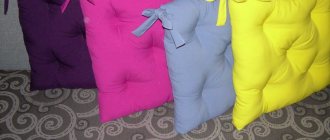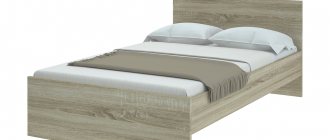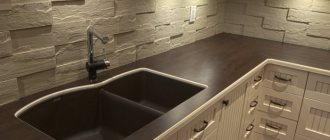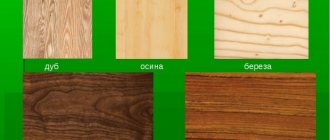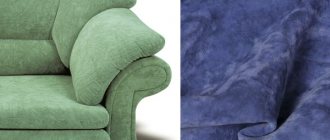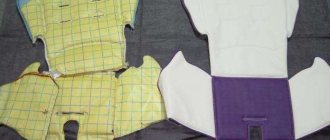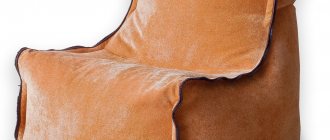Carefully selected chair covers are an important design element in living rooms and other spaces. It is necessary to take a responsible approach to their selection, manufacture and use, determined by the convenience and comfort that such items should bring to people.
Currently, it is impossible to imagine an apartment or house without such important pieces of furniture as chairs.
Sewing a cover for a chair, stool or armchair requires not only skill and craftsmanship, but also patience, imagination, flight of thought, demonstration of all possibilities, inclinations and talents, the desire to decorate the world around you, make it more pleasant and friendly.
To ensure that the chairs fit harmoniously into the interior and at the same time retain their beautiful appearance for a long time, they can be decorated with a variety of covers.
How to sew an attractive and beautiful chair cover with your own hands? The step-by-step instructions published below will help you do this quickly and efficiently. All that remains is to first decide on the style, the ideology of the work, select colors, fabrics, and methods of execution. Naturally, you need to prepare tools, from sewing machines and scissors. In a word, the work ahead is serious, intolerant of fuss and imperfections.
Chair covers will help decorate and update your interior.
Functional features of chair covers with backrest
Covers for the backs of chairs are a multifunctional product that faces a variety of tasks. The first of them is to preserve the surface of the chairs, standing varnish and the main structural material from premature destruction. The second is the ability to add comfort to a bedroom or dining room, practicality to a kitchen or study, chic, solemnity to a living room or large hall. The third is the ease of use of the chairs.
The cover will help protect the surface of the furniture from hand marks, spilled coffee or the impact of dropped scissors.
In a children's room, a cover on a chair plays a cheerful, playful role, creating a fun playful atmosphere for the child on the one hand, and coziness, peace and comfort on the other. There are always two or three chairs in a child's room; this is enough for their covers to play a prominent role in interior design.
Since they will be washed frequently, the covers should be easy to remove.
Modern and even classic cafes and restaurants cannot do without high-quality covers that can maintain a solemn appearance for a long time, even after frequent washing from ketchup, after active use by numerous guests. Covers for such establishments, just like for offices, public places, schools, hospitals and other institutions, must be durable and able to withstand exposure to adverse environments.
The fabric for them should be durable and wrinkle-resistant.
A high-quality and durable cover will protect a chair or chair from the sharp claws of a cat, dog, parrot beak or other pets. Yes, the cover will suffer from such “communication,” but a much more expensive armchair or chair will remain intact. The cover can be easily washed by hand or in the washing machine. And if necessary, you can sew a new one without the slightest damage to the design of the room.
Such simple covers serve as protection against dirt, wear, and also for updating old chairs.
Materials and tools
The fabric for chair covers is selected depending on the purpose of the furniture. Inexpensive textiles that are easy to wash and iron are suitable for the kitchen:
- Cotton: calico, teak, satin. It is advisable to duplicate thin material with double thread or a layer of non-woven fabric, so it will hold its shape better.
- Linen looks great due to its texture, but is difficult to iron.
- Fabrics containing synthetic fibers: polycotton, gabardine - wrinkle less and are easy to wash.
How to choose an orthopedic pillow for a chair according to shape and material
If we talk about new products, you can pay attention to supplex - elastic knitwear. It easily adapts to shape, does not accumulate static tension, and dries quickly. In addition, this material comes in bright colors, so suitable for the kitchen.
In the living room, chair covers are made from fabric that matches the rest of the textiles:
- jacquard, tweed, velor, flock - they have a rich texture and hold their shape well;
- corduroy and denim are appropriate in a modern interior or a teenager’s room.
Decorating halls for a wedding or other celebration involves elegant, well-draped fabrics. Flashy but inexpensive materials are suitable, since the case will be used for several hours. Optimal options:
- satin and silk are slippery, shiny, flowing fabrics that require lining and reliable fastenings;
- crepe-satin, gabardine, knitwear - their texture is more restrained and allows you to create beautiful frills and draperies;
- taffeta, veil - used to create airy flounces and lush bows.
Moms take different paths when choosing fabric for a highchair cover. Those who need practicality take waterproof materials, others value the baby’s comfort, and still others find a universal but expensive option. Each of them has both advantages and disadvantages:
- Eco-leather - oilcloth-based fabrics are easy to clean and are not afraid of spilled milk. But they are not hygroscopic - in the hot season the child will sweat.
- Velor and knitwear are soft - pleasant to the touch, but they will get dirty, and the cover will have to be washed often.
- NANOtex is a material with microparticles of silver with a water-repellent effect, breathable, does not cause allergies, spilled liquid can simply be blotted with a napkin.
Before cutting, the fabric must be wet-heat treated so that the finished product does not shrink. This is especially important for linen and cotton.
Additional materials that may be needed when sewing:
- lining fabric;
- padding polyester or padding polyester;
- fastenings and fasteners: elastic band, Velcro tape, buttons or zippers;
- braid, fringe, lace and other decorations.
In addition to the sewing machine, you will need: a measuring tape, a marker, scissors, pins and thread.
NANOtex
Velveteen
Denim Jacquard
Linen
Cotton
Where can it be used?
Step-by-step instructions for making chair covers will help solve the problem. If you sew a cover yourself, you can make the most suitable option for implementing any design solution or so that the product fits well into the design style existing in a particular room.
Ordering a custom-tailored cover is more convenient than finding ready-made capes that match the style, color and size.
Chair covers are most actively used in the design of living rooms, kitchens and other rooms in an apartment or private house. Their presence there is most necessary, since people are constantly present in these places.
The presence of people means that it is necessary to take care of the hygienic properties of the material from which the cover is made and its harmlessness to health, especially of children.
Universal models fit different chairs.
Another place where chair covers are used is in office spaces. This is a place where intensive work takes place, and where all things, including furniture, capes and covers, become unusable very quickly. Naturally, they urgently need to be replaced or repaired. And here step-by-step instructions will come in handy, allowing you to create a new original case at minimal cost.
These covers are especially ideal for chairs without armrests.
Chairs with covers are used in schools and other educational institutions. It’s easy to guess how quickly they break down, even if they are made of the most durable fabric. For places where children study, it is necessary to make especially durable covers that can withstand the frantic pressure of children's energy.
Anyone who has watched the movie “Orient Express”, or anything similar about railway transport, has noticed how rich, luxurious and beautiful the covers are on the backs of expensive seats. Not every master can make such a product. But if you try hard and study for a while, everyone can do it.
Due to the strength of the fabric, they protect the chairs from external influences.
Beautiful and expensive cases are used by heads of state, presidents of companies and corporations, and other people whose wallet allows such luxury. But the point is not in the cost of the fabric, but in the imagination and inspiration of the master. Even from ordinary chintz you can make a work of art.
The best cases, like the works of great masters, are always made for themselves and their loved ones. This usually requires patience, desire, imagination with inspiration, and the ability to find the required materials of the highest quality from underground.
Solid or thick covers completely cover the chair - both the back and the seat.
But it’s time to proceed to the next stage of making the case - choosing the style in which the work will be done. Certainty in this matter is especially important, since the style will be used in the decoration of the entire house or apartment.
DIY cover options
It all depends on skill and imagination. It is recommended to take several master classes. The color and stylistic design may not match the design of the room, this is acceptable. There are mainly two types of seat cover shape: circle and square. The seat can be thin, medium or thick. The upper part of the cover can be made similar to a thick seat, but with straps for fastening. If the cape is made in a traditional manner, that is, it fits the chair on all sides, then it can be made in many ways. A one-piece cover covers all parts of the furniture, with the exception of the bottom - this part is made in different ways: either right up to the floor, or slightly covering the seat. The separate option allows you to choose the length for the back. The top cape will also be attached with ties or fastenings-ties (to the sides of the back). You can sew an elegant “version” with bows, ruffles, and an extended hem.
Chair cover with fabric back
First, measure the length and width of the backrest, as well as the height of the chair. For the kitchen, it is recommended to make covers not the entire length, but with a margin of up to 30 cm. For the hall, covers up to the floor are suitable. When sewing, you need to take into account the thickness of the back, as it can be very thin (less than 1 cm) or thick (up to 6 cm). The width of the piece of fabric should be 2-5 cm larger than the chair. The length of the fragment is determined by the sum of the two lengths of the backrest, the length of the seat and its height, multiplied by two. To this number you will need to add a margin for seams. The cut is placed over the chair, the lengths are adjusted, and places for fastenings are marked. As a result, the cape is sewn so that it is tied to the legs with ties or connected between the floors with ties. In the second case, two or three such elements will be enough. It is better to place them at the back on the back.
DIY seat
First, the pattern is prepared. You will need a pencil and newspaper. Then these measurements are transferred to the material folded in half. For each of the legs you will need two ties about 10 cm long. A padding polyester is cut out according to a similar drawing. The width and length parameters are reduced by 1 cm. The laces must be folded in half in width, inside out; After that, stitch and turn right side out. With several large stitches you need to attach the padding polyester to the back and the ties to the corners. Now the entire seat is stitched, except for a gap 20 cm long. Through it, the cover will be turned right side out. The edges of the parts are sewn with a hidden seam. Next the seat is ironed. If you wish, at the very end you need to start final decoration using ribbons and various decorative elements. All this will take no more than a few hours, and if you have experience in sewing, half an hour to an hour.
Even before the stitching begins, the seat should lie like a glove.
Cover for a round stool
The manufacturing principle is similar to the method of sewing a cape for a square seat. The simplest option involves using an elastic band. First of all, measurements are taken from the stool and the diameter is determined. The fabric is marked with an allowance of about 5 cm. The reverse side of the fabric is folded by 2 cm. You need to stitch the edge 1 cm from the fold - the result is a “tunnel”. The elastic band will be located in it. The next stage is filling. Small cuts are made in the workpiece. The padding is distributed evenly throughout the seat. The incisions are carefully sutured - this is done only by hand. Then the product is machine stitched around the perimeter. Some cape models are visually similar to jar lids. Knitted covers will also look good on a round stool. In the process of creating them you need to use various loops:
- Airborne.
- Half columns.
- Columns, with and without crochets.
Crocheted covers
Such a product is quite easy to wash, and in order to knit it, you do not need much experience. It does not slip on the surface and is suitable for chairs where children sit. Among the crochet techniques, it is worth highlighting a stitch with three, two or single crochets, a single crochet, a double crochet, a strong stitch, an air loop and a half-crochet. Those who have little experience should find out which options are the simplest and master them first. It is necessary to decide on the pattern and knit without allowing it to unravel. For one cape you will need about 200 g of yarn, which is approximately one skein. There is a fairly simple scheme for creating a round cape. First, the diameter of the stool is measured. Then air loops are knitted and closed in a circle. Next, rows of different loops are made. The angle is leveled by skipping one of them. Once the required size is reached, you need to knit the sides for secure attachment to the seat.
Cover made from an old sweater
Equipment you will need:
- yarn needle;
- button;
- yarn;
- sewing pins;
- scissors;
- pencil;
- ruler;
- sweater (preferably wool).
First, the clothes are washed and dried on a radiator. The material will “shrink” and the sweater will decrease in size. A cape made of such wool will keep its shape well. Next, two rectangles are cut out with the same width but different lengths (with a difference of 8 to 10 cm). This stock should be used to create the cover of the case. It will close with a button. A fragment is cut out in such a way as to capture the elastic at the bottom of the sweater (if there is one). The edges will not have to be processed, and the cape itself will look neater. In order for everything to work out as efficiently as possible, you need to use a paper template. The cut out parts of the sweater are folded right sides inward. They are aligned and secured with pins. They are stitched everywhere except the top. The cover is turned inside out and ironed with steam. Finally, yarn is wrapped around the button.
Dressing up a children's chair
You will need approximately 1 m of fabric. Sewing a cape is not difficult, especially if the back is of a standard shape and there is no need to adjust it to fit the belts. All you need is two pieces of fabric and filling. Both fragments are stitched together. It is recommended to look for waterproof material that is easy to clean and wash. It is better to take the filler as soft as possible. Measurements are taken from the furniture. First of all, the length and width are determined. If the chair has an unusual shape, with a lot of allowances, then the easiest way to make the correct configuration is to attach the fabric to the chair or to an old cape and accurately repeat its outline. The next step is creating a pattern and marking the canvas. After this, the final stage remains - sewing to measure. The cape needs to be applied to the chair from time to time so that it does not have to be cut out and remade later.
High chair cover
You can make a three-layer cape. The front part should be made of velor or cotton fabric, the middle part should be made of siliconized padding polyester, and the top part should be made of rigid cotton fabric with or without synthetics. The high chair is placed on the floor, and a pattern is made from non-woven fabric or tracing paper. Holes are cut in places for stitching. To mark, place the pattern on the chair, press it tightly and mark the lines of the slots for bends and straps. The lapel details and gasket are cut out first. Then the edges of the parts are connected to the main gasket. After this, side folds are performed. The finished gasket is placed on the velor with the folds down. It is stitched with thread, and then velor is cut out. The structure is placed on padding polyester. The cover is stitched, but a hole is left for later turning the product inside out.
Patchwork style covers
First you need to sew the pieces of fabric together. This is done randomly from scraps of different widths or in regular rows from identical fragments. In addition to the main part of the product, you will need scissors, a needle, a machine, threads, fabric for the back, tape for the cover, and a sealant. Next, you need to work on the pattern. On a large sheet of paper you can outline the seat and draw seam allowances. A3 size is suitable, but you can also join several smaller sheets together, for example using tape. The pattern is cut out and tried on the chair. Next, three blanks of the same size are made: from the lining material, the seal and the fabric itself for the cover. The front part and the seal are folded, lines for stitching are marked. All components are superimposed. The ribbons are placed inside and the fabric is then stitched. The product is turned inside out through the gap left. You can use multi-colored pieces of the same fabric with the same pattern or parts of different materials:
- gabardine;
- jeans;
- leatherette.
Foot covers
These products are designed to maintain the good condition of the floor covering. In addition, the chair will not make unpleasant sounds from moving across the floor. There are many interesting ways of doing it, including covers in the form of socks and “cat’s paws”. Most of these products are knitted. Covers can be quickly made with your own hands, so there is no point in spending money on them. For knitting, it is recommended to use Darnichanka thread - it is very durable. The process begins by creating several air loops. Single crochets are made around them. In the third row you need double (two) single crochets from one loop and regular single crochets. In the next row, the same columns are sewn, but behind the far bow of the loop. In addition to them, it is necessary to make a sc from one loop and behind the far bow. In the next row - again regular single crochets. The thread is cut and secured. And so four cases. If desired, they are further decorated.
Office chair cover
The following devices will be needed:
- Scissors.
- Pins.
- Chalk.
- Linen elastic.
- Threads.
The main material should be comfortable and durable: wool, too soft and “biting” fabrics will not work. Gabardine is a good choice, it is durable and looks beautiful. First of all, measurements of the seat parameters are taken with a “meter”. Then they are transferred to the fabric. The drawing is made using a small piece of chalk. Space is left for allowances of about 10 cm. The pattern is cut out - the corners must be rounded. The edges are overlocked with an overlocker, folded one and a half centimeters and secured with pins. A stitch is made on a sewing machine, 3-4 mm from the edges of the hem, the pins are not removed. Thanks to this, the product does not need to be swept manually. The last 2-3 cm are not stitched, leaving room for an elastic band. It is passed around the perimeter and cut off. Ponytails up to 25 cm long are left.
Holiday case
The process of making a holiday cover yourself is no different from creating a cover for a chair with a backrest. The main difference is the cost of materials. Chairs should emphasize the festive atmosphere, so they are decorated with a variety of decorative elements: bows, ribbons, patterns. Such capes are used at banquets and ceremonies. The reason for creating a festive cape can be events such as Christmas, New Year, traditional holidays, receiving guests, birthdays, anniversaries. The New Year's cover should be decorated with Christmas trees and "Santa Claus hats." It is recommended to select the most expensive textiles, in bright colors. But any more or less elegant fabric will do. It is appropriate to use curtains and tulles under the sewing material. Velcro is sometimes created on the cover to accommodate various applications.
Wedding covers
The backs of such capes are elongated, square and round; Both glossy and matte surfaces look equally good. Crepe satin is suitable as a material. The main part of production begins with measurements and patterns. The characteristics of the chair model are taken into account. The parameters are marked on the sketch, after which you can start cutting. Then all the fragments are applied to the chair. After the first fitting, you need to create a pattern. If the shape of the back is not rectangular, but round or even more complex, then you will have to adjust the fabric several times, trying it on the chair itself. In order for the cover to perfectly emphasize the shape of the chair, you need to apply the paper directly to it and mark the narrowing and widening in all places. If the master does not have sufficient experience, then he will need to make several “trial” products.
Style selection
Before you start choosing a style for covers, you should understand which forms of this attractive product are most actively used. This is important because it gives answers to questions about choosing fabric, choosing its pattern, color, texture and texture.
This form is the most difficult to produce.
Experts divide chair covers into everyday and holiday ones. It’s clear with the first ones, they don’t look too bright, not too presentable, they are intended for intensive use at a time when no one pays much attention to either style or choice of fabric. Let's take these circumstances into account when preparing for the manufacture of covers.
Another chair covers are festive ones. By definition, such devices can only be made from expensive, beautiful, durable fabric designed for long-term use in adverse conditions.
As a rule, such covers are made from expensive materials.
The styles of chair covers that will be preferred are determined both by the tastes of customers, room owners, and by previously applied style solutions in the decoration of walls, furniture, and other important objects.
The classic style, although it looks somewhat old-fashioned and heavy, remains the most universal. A case made in this style is suitable for all design options and organically fits into compositions of great complexity.
Luxury covers add special chic and comfort to the room.
Provence style covers are lightness, a lot of light, peace and tranquility. Suitable for melancholic people who live secluded, but not lonely.
And there are also modern and high-tech styles. In general, in order to choose a design solution for cases, you need to think carefully. You should weigh up the pros and cons, get the consent of all interested people and realistically assess your financial capabilities.
Such different designs of cases
Any cape must correspond to the design features and dimensions of the chair. The standard back shape looks good with both short and long fitted covers. For chairs with non-standard configurations, shortened models are selected that do not completely cover the backrest. To make this interior detail with your own hands, you should show your imagination and make some efforts, then the room will be filled with new light.
For a classic interior, cape models with narrowed folds or gathers are suitable, which will give the chair rigor and neatness. Lush ruffles will add a touch of fun and flirty, and a bright insert made of braid or lace will add contrast. The edging along the bottom of the cover and back will complete the decor.
When creating capes to decorate your home with your own hands, you need to take thick, high-quality fabric. To begin with, it is better to practice on cheap material. Measurements are taken directly from the chair, so paper patterns are usually not used in this work.
Choosing fabric for covers
The wealth of types of fabrics that the market offers allows you to choose for covers what is best suited for them. You need to thoroughly study the features of all available options, take into account all the circumstances and choose something.
Covers made of cotton in pastel shades with prints in the form of flowers, checks, and monograms look beautiful.
- Cotton
Cotton fabrics are natural products, made from natural fibers, which has a great effect on the atmosphere in the room in which the covers are located. The material is easy to work with, and at the same time it remains strong and durable, protecting the seat from damage.
- Linen
This is a natural fabric, attractive due to its aesthetic surface and manufacturability. It is also easy to work with, but one must take into account not too much mechanical strength and susceptibility to rotting.
Products can be decorated with bows and lace.
- Silk
Expensive fabric that is only suitable for sewing formal covers, but not for everyday ones. Chair covers made of this fabric are good for rich homes and office spaces of large companies.
- Biflex
Synthetic knitted fabric, which is made from several types of synthetic fibers. This material, distinguished by its strength and resistance to all influences, includes microfiber, Lurex, nylon and other achievements of the domestic and foreign chemical industry. This is a wonderful appearance and the opportunity to realize your wildest fantasies.
For a classic style, you can choose fabrics in calm tones.
- Flock and microfiber
Fabrics made from polyester fibers that are well processed into wonderful covers that are resistant to sunlight, repeated washing and other processes.
Interior style and textiles for covers: creating a harmonious composition
To sew a cover with your own hands, you will need about two meters of fabric. Agree, this is much cheaper than buying new furniture, especially since this way you can favorably emphasize the style of the interior. Thus, covers made of cotton material are appropriate in country or Provence interiors.
In the English style, capes with buttons or stripes look organic.
Covers made of rough burlap are an excellent option for eco-style.
And to give the interior a modern touch, denim is suitable, and it harmonizes perfectly with wood.
When decorating classic interiors, it is better to use noble ceremonial covers. They add an aristocratic accent that is appropriate for the style. Here you need to choose a fabric of a calm shade.
The highlight of the design of themed events and holidays will be covers of the appropriate design.
Note: give preference to dense and strong fabrics that can withstand constant washing and stress. This is especially true for chairs in the kitchen and dining room.
How to choose chair covers for different rooms
Chair covers for a children's room should have a cheerful, light pattern, lightness and at the same time durability. And one more thing: design and texture must take into account the “audience” for which they are intended.
The covers, designed to protect the chairs that will stand in the living room, should look solemn and beautiful, in full accordance with the previously chosen style.
The fabric must be of high quality, dense and certainly beautiful.
In the kitchen, all furniture is constantly exposed to temperature, odors, and other unpleasant factors. Covers that will be used in this room must be made of durable fabric that does not absorb dirt and can withstand grease stains and other similar influences.
In the office and in premises related to public organizations, strong covers are needed that can withstand repeated machine washing and cleaning with chemicals.
Choosing dark colors for capes, such as burgundy or black, will emphasize the refined taste of the home owners.
Decent kitchen decoration
Chairs placed around the table will add solemnity to the atmosphere. Kitchen covers should be made of practical fabric, easy to care for and consistent with the overall design of the room. Therefore, it is best to choose dense material that can withstand increased load. Too expensive fabrics are not needed here: frequent washing will quickly put them out of action.
In some cases, you can make your own cape from pieces of existing fabric. This patchwork technique will be an excellent addition to a country style room.
Cotton or synthetics are perfect for the kitchen; they will not only protect the chairs from dirt, but also ensure ease of cleaning. The covers can be decorated with applique according to the theme of the room. To sew a set of such covers, you need a pattern, which can be obtained by taking measurements from the chair and tracing the seat. Braid, fringe, satin ribbon or a lush bow will become a bright part of this decorative element and give it completeness.
How to sew a cover for a chair with a back: instructions
Necessary materials and tools. In the most natural way, for such work you will need fabric, the style and color of which has been previously selected; threads and needles, scissors, rulers and soft meters will not interfere. It’s best to take your own or rent a sewing machine from a specialized company. It should be borne in mind that not all machines are capable of working with thick fabric of seat covers. The same circumstance should be taken into account when choosing needles for a sewing machine.
Fans of bright accessories can choose capes in more saturated colors.
There is a more effective solution to the problem with a special sewing machine. No, you don't have to sew anything by hand! This is expensive and unpromising. You just need to contact a specialized company whose seamstresses will cope with such tasks in a matter of hours.
We take measurements. It is imperative to take care of the accuracy of the dimensions taken by the measurer. This requires, accordingly, an accurate instrument and considerable experience as a measurer.
Any chair can be made original with the help of decor.
The entire chair must be measured, in all its details. These are height, width, depth, dimensions of the back and seat, and many other structural elements. If you ignore this step or don't take it too seriously, the cover will definitely turn out to be either too tight or too small, and will not look as planned.
To sew various covers for chairs with backs with your own hands, you need a pattern. To do this, we prepare a schematic drawing of all the parts of the chair, after which we assemble everything into a single picture. Carefully transfer the drawing in natural sizes onto the paper and no less carefully transfer the drawing onto the straightened fabric. Typically, white or other colored chalk is used for drawing on fabric. It washes well, or even can be removed without washing, by shaking it out as usual. And it does not cause any harm to the fabric. A certain accuracy is required from patterns, and the cutter must not forget to leave some margin so that it is possible to sew the parts where provided.
A single composition is obtained from combining different pieces of fabric.
Sewing covers for office and other chairs with your own hands, according to step-by-step instructions, is not as difficult as you might initially think. Next, just take a good sewing machine, and all the parts are carefully sewn together. It is necessary to ensure that the seam that goes through the covers of home chairs without a back is smooth and strong, and that there are no tears. Otherwise, when you first put it on, the cover may be damaged, and it will have to be repaired during the initial period of use. However, you must always be prepared to replace something in the chair covers, put it in order, and repair it.
The material must be chosen to be hypoallergenic and, if possible, water-repellent.
Constructing a pattern
It’s easy to sew a chair cover yourself, the main thing is to choose a model and form the pattern correctly. There are no universal samples for this, since furniture designs are different. It is better to make blanks according to individual measurements. What is needed to make a pattern for a chair cover is a question that should be considered in more detail. Basic recommendations:
- First, measurements are taken. You need to measure not only the width, but also the depth of the seat, as well as the height of the backrest. It is important to know that for some models these parameters may be different at the front and rear. If you are sewing a cape with a skirt, you need to measure the height of the chair itself and take into account the inclination of its legs.
- You need to pay special attention to the shape of the corners of the furniture. They can be straight or round.
- If the chair has an unusual shape, for example, with a round seat or a curved back, the pattern can be made directly on it. Sometimes it is necessary to make individual parts so that the product accurately follows the curves, for example, side inserts.
- When cutting fabric, be sure to allow seam allowances. It is also important to take into account that the material can shrink when washed, so it is better to sew a cover for the chair that is a little larger in size or wash the piece in advance.
It is recommended to make complex patterns for chairs with backs from paper. It is applied to the furniture, secured with tape, and then cut. Such a pattern turns out to be accurate, it is easy to adjust it to size, change it, and improve it. Then the paper parts are applied to the selected material and cut out.
You can do the same with fabric. To do this, take cheap material or an old sheet. The fabric is applied to the chair, cut and sewn. At the same time, you can see what the finished product will look like, remove its shortcomings, and redo it if necessary. After this, the seams are ripped out, and the trial version is used as a pattern.
Beautiful examples and options
There are an unusually large number of sites on the Internet that specialize in the production of furniture and accessories. You can usually find a large number of the best options for chair covers on their pages. The visitor will be amazed by the wealth of choice.
Chairs with covers are found everywhere. If you look around you carefully, you can see a lot of interesting things that are then used in your own practice of making covers.
Stylish chairs will advantageously complement other interior elements.
Practical bar stools with covers, products for a computer club, numerous solutions developed by specialists will be the best help in deciding which covers to make for your family with your own hands.
Calculations and measurements
Before you start sewing covers for kitchen chairs, stools for a children's room or any other furniture, you need to take measurements of the furniture and prepare patterns.
Sewing covers follows a general pattern, regardless of the furniture model:
- Take measurements. It is important to measure all the parameters of the backrest, seat, and recesses. It is important to pay attention to the legs. On some chairs they sometimes widen or narrow towards the bottom. It is required to write down all dimensions exactly to the millimeter.
- Draw up a drawing on tracing paper based on the measurements obtained and cut it out.
- Apply the stencil to the seat and back. Check whether the entire surface will be covered with this scheme and whether there is room left for a seam.
- Transfer the pattern to the canvas, cut it out, leaving 2 cm from the edges for seams.
- Next, all that remains is to sew on the sewing machine along the intended lines and overlay the seams.
Covers for chairs with backs – 50 original ideas:
PreviousChairsDecoupage of a chair - breathe new life into old furniture
Description and purpose
Chair covers are nothing more than special furniture covers of different cuts and colors. These can be very laconic removable products with simple fasteners or complex covers for packing chairs. Depending on the type of chairs, they vary in modification; they can provide for the entire chair to be closed or only its seats. Models differ in the degree of adhesion of the material to the surface of the elements being closed.
Some of them fit quite tightly, following the contours of the furniture. They are made in the form of a single element, worn on the back. Others are sewn in such a way that they are not put on chairs, but are wrapped in textiles around the back and seat.
The buyer chooses the type of cut independently, based on budget capabilities, the specific type of chairs and his own taste preferences. Regardless of the choice of model, it has a decorative and practical function. This product prevents premature destruction of furniture, protecting its working surfaces from accidental scratches and other mechanical damage.
In addition, capes give chairs a more aesthetic appearance, improving the overall appearance of the interior. Together with the tablecloth, they add elegance to the dining group. When combined with the colors and shape of the curtains, they make the atmosphere of the room homely and inviting. When choosing the right design, they become a bright accent of the interior, giving it the necessary status.
